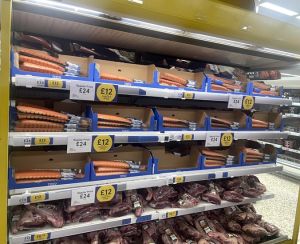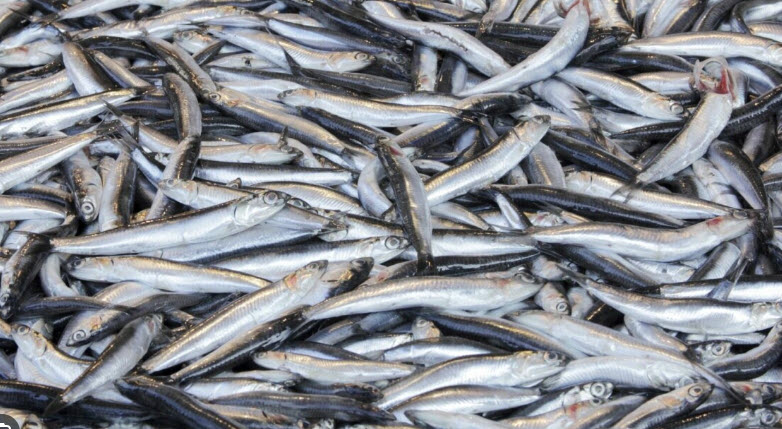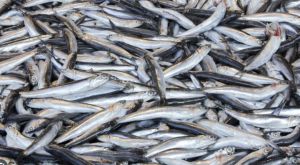Foraging: I do find it puzzling when researchers from the Institute of Aquaculture advocate that consumers should eat wild caught fish rather than fish that have been farmed. These researchers have co-written a paper with researchers from three other institutions. The lead author has a record of promoting reduced consumption of farmed fish such as salmon in favour of species such as mussels. However, I am not sure that there is much of a demand for mussels en-croute.
The proposition promoted by the paper, published in Nature Food, is that more nutrients are available from forage species such as anchoveta and blue mackerel than from farmed salmon and therefore the public would be better off eating the forage species than farmed species like salmon and trout and I suspect like species such as sea bass, sea bream and even basa. In the year end to February, the consumption of the following species as chilled fish in tonnes is as follows:
Farmed
Salmon 53,083
Sea bass 4.097
Basa 3.044
Trout 1,121
Sea bream 717
Wild-caught
Mackerel 5,882
Herring 1,236
Anchovy 245
It seems that in the UK, farmed fish are highly favoured (although the salmon figure will include a small amount of imported Pacific salmon and the sea bass will include a small amount of locally caught fish – usually much larger in size). By comparison, consumption of what are described as forage species are extremely low. Whether mackerel and herring are transformed into fish meal is questionable as certainly there is a demand for these species abroad.
The researchers say in their paper that salmon consumption is about 80,000 tones compared with 20,000 tonnes of mackerel and less than 3,000 tonnes of herring, anchovy and whiting. Their data comes from 2019 which is surprising as new data is available every month. Seafish’s data for February this year does not include whiting although I have seen it available in Scottish stores. Unfortunately, the researcher’s data is flawed because the difference between their and my figures comes from the inclusion of ambient and frozen salmon, which is likely to be all wild caught Pacific salmon.
The other flaw in their argument is that farmed salmon are fed on increasingly less wild fish than they used to be. Inevitably, this will have an impact on the nutrient profile of the salmon and if this is compared directly with the nutrient profile of wild fish, then the wild fish will always appear to have a better overall nutrient content. However, the public do not eat fish because one species has higher calcium, iodine, iron, Vitamin B12 or even omega 3 than another, they eat it because they like it.
The researchers say that because wild fish are more nutrient packed, it is possible to eat a smaller portion to obtain the benefits and therefore there will be less pressure on wild fish stocks. However, consumers may choose to eat larger portion sizes because smaller ones do not fill them up. They say that making a few small changes to the diet around the type of fish that are eaten will go a long way to changing some of the lower nutrient levels found in salmon and increase the health of both the population and the planet. Yet, the health of the population would benefit more from other major changes such as less sugar, less salt, less processed food and so far, the public has been slow to respond to messages advocating a healthier diet. It is extremely unlikely that the public will respond to calls to eat more forage fish species to improve their health.
As Salmon Scotland told Fish Farming Expert. There is nothing stopping people from eating other wild-caught fish like mackerel, anchovies, or herring but people do not choose to do so. What is concerning about the advice given in this paper that people should eat less salmon and more wild caught fish is that current consumption is still only half that of the Government’s two a week recommendation. We should be promoting the consumption of any fish to try to boost this. Any negative messages such as the one in this paper only help deter the public from eating any fish at all.
Sadly, the paper makes no suggestions as to how consumption of these wild caught species can be boosted. This is in line with those from the environmental lobby that demand farmed salmon should be boycotted because its use of fishmeal is allegedly depleting local communities of their protein sources. Surely, if these groups want people to eat more forage fish species, then they should be promoting consumption of these species directly to the public rather than calling for a ban on salmon farming. There is a good reason why they don’t and that is the public won’t respond.
Interestingly, CEFAS wouldn’t fund the only project submitted to the Seafood Innovation Fund that aimed to try to increase consumption of lesser-known species. If a fish-based government agency wouldn’t try to help change consumption habits, then there is little hope of ever doing so.
Cod v salmon: The chief analyst of Nordea Bank asked in Intrafish why does salmon cost more than cod. He offered 5 reasons why cod is cheaper than salmon.
- Product development in salmon is more highly developed than for cod.
- The market for salmon has been developed outside the usual customers. New markets in Asia in the USA have opened up for salmon.
- More salmon enters the hospitality industry including restaurants,
- There are fewer substitutes for salmon whilst cod has competitors from other white fish.
- Salmon can be eaten all year round whilst wild caught fresh cod is seasonal.
This analysis ends with the suggestion that cod prices will rise if the cod sector focuses on market development.
I would suggest another reason why cod prices are lower. This is simply due to a lower demand for cod and in the longer term, this demand will fall. To put it bluntly, cod is much like other similar whitefish with little extra to attract a wider consumer base. In addition, there are several other white fish species competing for this declining space. In the UK, it is likely that the main outlet for cod is in fish and chips but for many consumers the fish could be any species. It doesn’t really matter when the fish is coated in a tasty batter. Some years ago, the environmental groups made a great fuss about the state of cod stocks in UK waters and as a result, the large processors of frozen coated products swopped over to alternatives such as Alaska Pollock. Now cod is back in the marketplace, even if most comes from outside the UK, at a reasonable price, many of the Alask pollock products have reverted back to cod. This is not because consumer specifically want cod but because the marketeers play on UK’s association with cod. It is what is expected, not necessarily wanted.
The predictably availability, generally predictable price and predictable quality has meant that salmon was ripe for product development. In the UK during the late 1990s and early 2000s, salmon was developed into many products because the price made it economically viable., In more recent years and for a variety of reasons, the price of salmon has increased making it too expensive for added value processing and consequently, the range of products has diminished. Attempts have been made to use fish species such as cod, but they have failed to attract consumers. There are examples such as cod in caper and lemon butter with a 260g pack priced at £6.00 but such products are very few in number and they generally struggle to gain market share in the current marketplace.
What’s interesting though is that whilst the Nordea analyst claims cod is priced below salmon, those prices are not reflected in the retailers. And they never were.
I have looked back at my records for cod and salmon prices, and I can go back to 2007 in my current format. Comparing prices in one retailer (others are similar) there is little difference between cod and salmon. (£/kg)
| 2007 | 2024 | |
| Cod fillet | 11.49 | 19.00 |
| Salmon fillet | 11.93 | 18.74 |
| Cod loin | 12.68 | 23.91 |
| Salmon loin | 13.29 | 29.17 |
What the prices don’t show is that whilst there are just two product choices for cod, there are several for salmon, including 4 fillets, a joint, organic, branded as well as the loin. This means that to help differentiation, the loin price is now higher than might be expected. Of course, the volumes are likely to be much smaller as the majority of sales occur in the more standard product range.
If cod producers want to see a price rise, then the solution is getting more of the public to want to buy cod. However, this will be a hard sell because cod is still a relatively indistinguishable white fish. If prices do rise, higher prices will simply deter buyers, not attract them.
Easter: Salmon Business reports that there was an upward trend in salmon prices in the run up to Easter with prices reaching near record levels. Prices ranged from NOK 100 to smaller fish to NOK 130 for fish over 6kg. In part the high prices were because of a shorter working week and a surplus of production fish (fish that need to be processed before sale).
Large fish may be attracting the best prices, but they are not normally seen in the retail market as they are sent for processing. It is the smaller 2-3k kg fish that are more suited to the dinner table that are seen on supermarket shelves. However, with each passing year, demand for these whole fish is falling as consumers appear to prefer filleted whole sides instead. Fewer supermarkets than ever are selling whole fish.
What is of interest is the price of these whole fish in the retail sector this Easter. With Norwegian spot prices attaining NOK 100/kg for 2-3 kg fish, which is equivalent to £7.30/kg in sterling, Aldi was selling whole fish for just £6.99/kg whilst Sainsburys price was £7.50/kg.
The spot price is rather misleading as it reflects specific market conditions. Easter used to generate a clear price peak as one of the two times in the year when salmon was consumed in volume. Now salmon consumption happens every day, and thus the price peaks that used to occur have long since vanished.
Meanwhile, most consumers who wanted salmon at Easter were choosing the full salmon sides which retailed at around £11-12/kg (NOK 150-160/kg) Observations from stores suggest that demand has been strong. This is not surprising, as salmon remains the most popular fish in the UK for home cooking.



